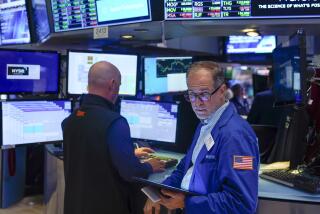Maybe It’s Time for Dividends to Shine Again?
- Share via
Amid the threat of electricity blackouts last week as the California power grid strained to keep up with demand, some people had a better idea than turning up the thermostat.
They bought electric utility stocks, pushing the Standard & Poor’s index of 28 major utilities up 5.9% for the week.
If you can’t beat the heat or the air-conditioning bill it’s going to cost you, you can at least hope for a rebate of sorts in the stock price and cash dividends of a power producer, some investors may have figured.
Whoever they were and whatever their motives, buyers pushed shares of PG&E; Corp., the parent of Pacific Gas & Electric, up 7.6% for the week, from $26.44 to $28.44 on the New York Stock Exchange.
Edison International, the parent of Southern California Edison, rose 5.1% for the week, from $19.63 to $20.63 on the NYSE.
If that still doesn’t seem like much to brag about at the neighborhood barbecue this weekend, try these stats on for size: For the year to date, the S&P; electric utility index is up 16.6% in price, while the once-invincible Nasdaq composite index is down 6.9%.
But with utilities, unlike with so many “new-economy” stocks, the price gain is only part of the story. The other part is dividend income--real cash money, paid to investors on a quarterly basis, suitable for investing elsewhere or for spending on that bigger Weber grill you’ve been eyeing at Home Depot.
If the concept of “total return” on a stock--price change plus dividend income--causes a giant question mark to form in a cartoon-style bubble above your head, chances are you just started investing in the last 10 years or so.
Who cares about dividends? Relatively few investors today, that’s for sure. Plenty of companies have stopped caring, too--which is reflected in the dwindling number of firms raising dividend payments on a regular basis.
Stock price appreciation is what America wants, and that’s what America got in the 1980s and 1990s, in spades.
So far this year, however, price appreciation has been harder to come by. Along with the Nasdaq composite, the blue-chip Dow industrials and Standard & Poor’s 500 index also are down year to date, 6.3% and 0.4%, respectively.
This isn’t the first time that stocks, on average, have been down for a couple of quarters, of course. It certainly won’t be the last time. The question that investors ought to be asking, many financial advisors say, is what kind of price appreciation is likely in the U.S. stock market over the next decade, rather than over the next few months.
Because if the long-term appreciation picture isn’t going to come close to what we’ve enjoyed in the last 20 years, other ideas for boosting returns--via dividend income, for example--may become much more interesting to investors.
*
Income-producing investments in general have proved a far better bet this year than the average stock.
Courtesy of the Federal Reserve’s yearlong campaign to raise short-term interest rates, money market mutual fund yields are at their highest levels in nine years, with the average fund yielding about 6.1%, annualized.
The value of longer-term fixed-rate bonds, meanwhile, suffered early this year as the Fed pushed rates up. But the relative dearth of supply of Treasury bonds (as Uncle Sam has paid down debt) and, lately, the growing belief that the Fed is done tightening credit, have caused market yields on Treasuries to slide.
On Friday the annualized yield on the two-year Treasury note ended at 6.16%, down from a peak of about 6.90% in May and the lowest in nearly eight months.
Likewise, yields have tumbled on tax-free municipal bonds in recent months.
Although new buyers of bonds are getting lower yields than they would have a few months ago, those who bought earlier this year are enjoying not only the interest income paid on the bonds, but a rise in the bonds’ underlying market value.
There, again, is the concept of total return--an investment’s price change, plus interest or dividend income earned.
If the investment appreciates, the investor might view the interest or dividend income as mere gravy. But if the investment falls in value, or rises only modestly, the interest or dividend income becomes far more important in providing a decent overall return.
Consider the numbers so far for electric utility Sempra Energy (ticker symbol: SRE), parent of San Diego Gas & Electric--which has been vilified for raising electric rates under California’s electric deregulation plan.
The stock price has lagged many other electric utility shares this year. It’s up 11.2% since Jan. 1, from $17.38 then to $19.31 as of Friday.
But Sempra also pays a $1-a-share annual cash dividend. If you bought the stock at $17.38 a share at the start of the year, the annualized dividend yield on your shares is 5.75% (divide the dividend amount by the stock price).
Say the stock ends the year where it is now. Your total return for the 12 months would be the 11.2% price gain, plus the 5.75% dividend yield. So your total return becomes about 17%.
Even if the stock falls from here, you could still end up with a double-digit total return. Even a 5% net price gain for the year, when combined with the dividend, would mean a total return of nearly 11%.
A new-economy stock such as Microsoft Corp., by contrast, must generate its entire return for investors from stock price appreciation, because the company pays no cash dividend. So there’s no cushion for investors when the stock falls--you simply endure it.
From the 1930s through the 1980s, cash dividends were key to the overall returns that stocks provided investors.
In every one of those decades, dividends never accounted for less than one-fourth of the total return of the blue-chip S&P; 500 index.
In the 1950s, for example, the S&P;’s average annual total return was 19.4%--even better than the returns in the 1980s and 1990s.
But the return from S&P; dividends alone in the ‘50s was about 5.3% a year, according to Ibbotson Associates in Chicago, which tracks historic returns.
In some decades, dividends provided the bulk of the S&P;’s return, as price appreciation was minimal.
That was the case in the 1970s: The net appreciation of S&P; stocks in the ‘70s worked out to just 1.6% a year, on average. Dividends, meanwhile, provided a 4.1% average annual return on the S&P; 500 in that decade--the only good reason to stay in stocks.
*
In the 1990s bull market, much of market history was turned upside down. Cash dividends became a major casualty of investors’ new-era thinking about stocks.
Many investors no longer wanted income from their stocks. They wanted price appreciation. It made sense from a tax perspective: Long-term capital gains on stocks now are taxed at a 20% maximum rate. Ordinary income, such as dividends, are taxed at regular tax rates, which for investors in the highest federal marginal tax bracket means nearly 40%.
Companies got the message. Many that paid dividends got stingier with their money, increasing dividends at a slower rate. Many firms that didn’t pay dividends, such as most technology companies, saw no reason to start paying them.
Instead of paying out more of their profits to shareholders in the form of cash dividends, many companies argued that money not needed for expansion of the business would be better used to buy back shares in the open market--with the goal of driving up the stock price, thus increasing shareholders’ capital gains.
(Conveniently, those repurchased shares could be used to provide stock for management’s lucrative options programs.)
In the 1990s overall, the S&P; 500 index’s total return averaged 18.2% a year. But dividends accounted for less than 15% of that total. The rest was price appreciation.
As share prices have soared and dividends have grown modestly at best, the annualized dividend yields on many stocks have become minuscule. Indeed, the overall annualized dividend yield on the S&P; 500 now is a mere 1.1%.
Which raises some interesting questions. Mainly: What if blue-chip stock price appreciation in this decade is a shadow of what it was in the 1980s and 1990s? For many stocks, there’s no significant dividend return to make up for a lack of appreciation.
It’s probably a stretch to suggest that investors will soon begin to harangue corporate boards of directors for higher dividend payouts. The tax code still favors capital gains, after all. And for many companies, the question is whether the earnings would be there to even allow for higher cash dividends.
But nearly every survey of individual investors shows their expectations for stock market returns remain in the stratosphere for coming decades. A recent survey by Scudder Kemper Investments found that Americans believe a “reasonable” return on stocks is 21.7% a year. Even the oldest investors in the survey thought 16% a year was reasonable.
If the market’s price appreciation doesn’t get us there in the ’00 decade, however--for whatever reason--could more investors begin to appreciate stocks that provide dependable dividend income?
Whether that’s what is behind investors’ stepped-up buying in such high-dividend stock groups as utilities and real estate investment trusts this year isn’t certain. Many buyers may just be piling on to these stocks as the latest momentum plays.
Still, every trend has to start somewhere. Is this the beginning of a dividend renaissance?
*
Tom Petruno can be reached at [email protected]. For recent columns on the Web, go to http://mediakit.nohib.com/petruno
(BEGIN TEXT OF INFOBOX / INFOGRAPHIC)
How Dividends (Used to) Matter
Until the 1990s, cash dividends never accounted for less than one-fourth of the total return of the blue-chip Standard & Poor’s 500 index in any decade.
*
Average annualized total returns for the Standard & Poor’s 500 index in each decade, and the share of those returns produced by dividend
income versus by price appreciation:
*
Source: Ibbotson Associates
More to Read
Inside the business of entertainment
The Wide Shot brings you news, analysis and insights on everything from streaming wars to production — and what it all means for the future.
You may occasionally receive promotional content from the Los Angeles Times.










